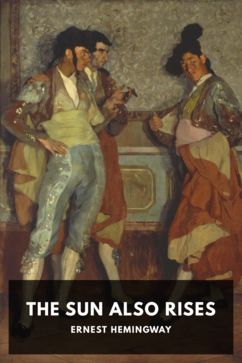The Sun Also Rises

Description
The Sun Also Rises was Ernest Hemingway’s first published novel, and the novel that introduced the term “Lost Generation” to describe the generation that came to adulthood during World War I.
The novel follows Jake Barnes, an American expat living in the Parisian café society of the roaring 20s. A wound sustained during the war has left him unable to have sex, and that drives a wedge between him and the woman he loves: Brett Ashley, a twice-divorcée who has embraced the sexual freedom and independence of the age. As they drift through their lives in postwar Paris, they find themselves on a trip with some friends to Spain to witness the Festival of San Fermin, a week-long bacchanal whose highlight is bullfighting.
Hemingway explores the aimless, heavy drinking, and dramatic lives of Jake, Brett, and their friends as a means to reflect the Lost Generation as a whole. Jake is a character of troubled masculinity: his war wound has fundamentally changed him as a man, and his behavior is often tentative, unsure, and placating. On the other hand, Brett is an enigmatic New Woman: free to drink and carouse with the men, she is seductive, but aching for the reassurance and love of a real relationship, and not just sex. The satellites of friends that orbit around them are equally troubled, drinking to excess and fighting with themselves and with others.
These complex characters are now mere spectators for the bullfight, a microcosm of war and death whose masters, the matadors, are the powerful and elegant emblems of masculinity that the Lost Generation finds it impossible to compete against.
Though initially met with mixed reviews, modern critics consider it to be Hemingway’s best novel. The characters and events are largely based on real-life people in Hemingway’s social circle and his time spent in Paris and Spain. Thus, the book sold very well in its first print run, as the expatriate community was eager to read about the coded scandals of their peers. Today it is recognized as a foundational work of the modernist style, and an American classic.
Read free
This ebook is thought to be free of copyright restrictions in the United States. It may still be under copyright in other countries. If you’re not located in the United States, you must check your local laws to verify that this ebook is free of copyright restrictions in the country you’re located in before accessing, downloading, or using it.

Download for ereaders
-
Compatible epub — All devices and apps except Kindles and Kobos.
-
azw3 — Kindle devices and apps. Also download the Kindle cover thumbnail to see the cover in your Kindle’s library. Despite what you’ve been told, Kindle does not natively support epub. You may also be interested in our Kindle FAQ.
-
kepub — Kobo devices and apps. You may also be interested in our Kobo FAQ.
-
Advanced epub — An advanced format that uses the latest technology not yet fully supported by most ereaders.
Read online
A brief history of this ebook
More details
Sources
Transcriptions
Page scans
Improve this ebook
Anyone can contribute to make a Standard Ebook better for everyone!
To report typos, typography errors, or other corrections, see how to report errors.
If you’re comfortable with technology and want to contribute directly, check out this ebook’s GitHub repository and our contributors section.
You can also donate to Standard Ebooks to help fund continuing improvement of this and other ebooks.